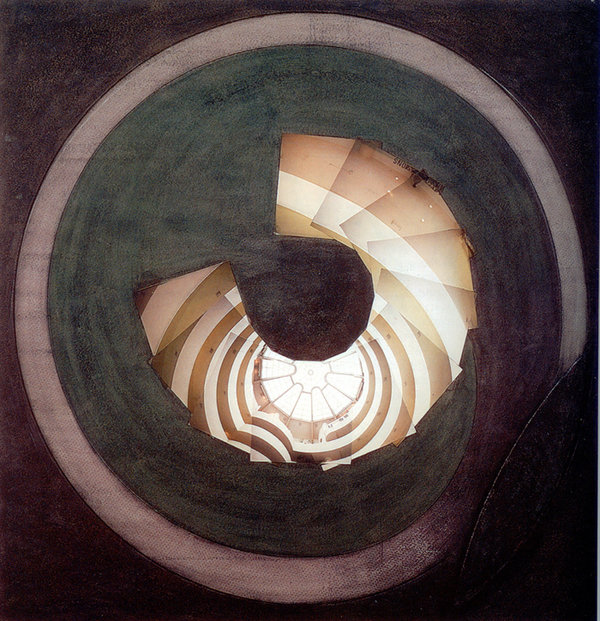8/3/2009
Jan Dibbets
Gallerja, Roma
L'esposizione si articola intorno a lavori emblematici della fine degli anni Ottanta in cui la fotografia ritagliata dialoga con lo sfondo pittorico. Questi lavori sono prefigurati da un'opera capitale, Guggenheim III, una rappresentazione della vetrata e dello spazio elicoidale del celebre museo newyorkese. La realta' diventa "astratta" attraverso la sua re-inquadratura in montaggi panottici.

-------english below
L’esposizione presso Gallerja, prima personale romana di Dibbets dal 1976, si articola intorno a lavori emblematici della fine degli anni Ottanta in cui la fotografia ritagliata si sofferma a dialogare con lo sfondo pittorico. Questi lavori sono prefigurati da un’opera capitale, Guggenheim III. Capitale perché la rappresentazione della vetrata e dello spazio elicoidale del celebre museo newyorkese chiude la fase delle costruzioni panoramiche e polifotografiche che l’artista riprenderà nel 2003 con un omaggio a Saenredam al Musée Zadkine di Parigi. La serie Guggenheim pone la questione della legittimità dell’utilizzo del montaggio panoramico.
Di fatto, il panorama è, nell’uso corrente, una modalità costruttiva il cui obiettivo è quello di fornirci un campo visivo che trascende le nostre capacità ottiche. Al contrario, nei suoi Guggenheim, Dibbets ci pone dinanzi a una realtà che non oltrepassa più lo spettro della nostra visione ma che si inscrive in essa: la realtà diventa così, attraverso la sua re-inquadratura, “astratta” quanto i montaggi panottici.
Operando in tal modo, Dibbets crea una mise-en-abîme della fotografia, perché offre una visione frammentaria di ciò che costituisce già in sé un frammento di realtà, “ritagliando” attraverso la sua rilettura elicoidale ciò che si distingue come ritaglio. Provocando e riflettendo i suoi limiti di “utilizzo”, la serie dei Guggenheim rappresenta dunque la fine (provvisoria) del montaggio panoramico fotografico nell’ambito dell’opera di Dibbets e annuncia la reintroduzione dell’immagine isolata che riuscirà, con altri mezzi, a provocare quella mise-en-abîme. I lavori concepiti nella continuità di Guggenheim III si propongono di riconfigurare le fotografie ritagliate senza con ciò abbandonare il dialogo con le superfici pittoriche.
Alle fotografie di Montepulciano e del Palacio Güell, in cui compaiono ritagli circolari, l’artista sostituirà progressivamente forme ellittiche che circoscrivono i contorni delle finestre e dei rosoni delle chiese, riprendendo il principio di distorsione. Ma a differenza delle correzioni di prospettiva che cercavano di esacerbare le proprietà superficiali della fotografia, Dibbets con le sue finestre intende provocare effetti di profondità che, se così si può dire, attraversano da parte a parte le esteriorità pittoriche. Il risultato è una vertigine.
La mostra con i contributi critici di Bruno Corà, Rudi Fuchs, Erik Verhagen resterà aperta fino al 9 maggio 2009.
-------english
The Gallerja exhibition – Dibbets's first solo show in Rome since 1976 – is built around iconic pieces from the late 1980s modified to include a cut photograph that dialogues with a painted background. These works were foreshadowed by the crucial Guggenheim III – crucial in that this representation of the glass roof and helicoidal space of the famous New York museum concludes the episode of the panoramic, multiphoto constructions which the artist would return to for a tribute to Saenredam at the Musée Zadkine in Paris in 2003. The Guggenheim series raises the issue of the legitimacy of the use of panoramic montage.
In terms of its everyday use the panorama is a constructive mode whose goal is to offer a field of vision that clashes with our optical abilities. In his Guggenheims, by contrast, Dibbets confronts us with a reality that does not exceed our visual range but, rather, becomes part of it; thus this reality, by being reframed, is rendered just as ''abstract'' as the panoptic montages. In this way Dibbets produces a kind of mise en abîme of photography, ''cutting'' via his helicoidal reinterpretation what already appears as a cut and so providing a fragmentary view of what is already, in itself, a fragment of reality. Both triggering and reflecting the limits of its ''use'', the Guggenheim series thus embodies the (provisional) end of panoramic photographic montage within the Dibbets oeuvre and the reappearance of the isolated image which, by other means, will bring about the mise en abîme.
And so the works coming in the wake of Guggenheim III set out to reconfigure the cut photographs, but without abandoning the dialogues set up with the painted surfaces. Gradually the artist would replace the photographs of Montepulciano and Palacio Güell, which include circular cuts, with elliptical shapes outlining the contours of windows or church rose windows in a return to a principle of distortion. In contradistinction to the Perspective Corrections that seek to heighten the superficial properties of photography, Dibbets is aiming here, with his windows, to create effects of depth which, so to speak, pierce the pictorial envelopes. The outcome is dizzying.
The exhibition with the critical contributions of Bruno Corà, Rudi Fuchs, Erik Verhagen will be opened until may 9th.
Inaugurazione ore 18
Gallerja
via della Lupa, 24 (Fontanella Borghese) - Roma
Martedì-sabato 11-13.30 / 15.00-19.30
Ingresso libero



